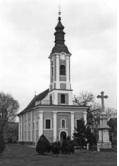After the Great Emigration in 1690, the settled Serbs in Senta raised their first religious place west of today’s temple, at the end of today’s park in the city center. It was built of bullets and braids, and after the construction of a new church of hard material, in a sanctified place in 1809, a cross was placed, which was later moved to the church port. The 1761 Census of Population in Senta states that the Serbian Orthodox Church in Senta was built “again and recently of hard material, of bricks and stones, and that there were a total of 374 believers and had two priests.” According to the records of the parish Timothy Brankovic, the first church of “hard material” was built in the place where it still stands today. The iconostasis in the church was painted in 1782 by Jovan Isajlovic Elder, “a painter from the Metropolitan Dalj”. The church was badly damaged in the fall of 1849.In the year when the roof, the tower, the interior was burnt, and on that occasion, the iconostasis fell.
The founding of the temple began in 1851, and on that occasion the bell tower, which was standing free from three sides, was joined to the side spaces of the baptistery and entrance to the bell tower. This is a high baroque bell tower completely attached to the church’s foundation, which changed the appearance of the facade. According to the spatial concept, the very basis, and the interior and exterior architectural elements, the proportions of the basic parts of the temple, the church was built on the model of the Georgian church in Sombor, under the influence of which Orthodox temples were built for nearly three decades in this region.
The church is basically single-breasted, with a five-legged apse on the outside and inside, and with shallow rectangular singing outbursts, which in particular emphasize, in the interior, the cruciformity of the temple. The western facade is somewhat more pronounced, and two pairs of pilasters emphasize the vertical split, and this is also contributed by the high baroque bell towering centrally. Central entrance is placed above which in the lunette the icon of the patron of the church is painted. The wall canvas along the whole building is made in the spirit of classicism, divided by shallow pilasters, it is also without architectural plastic, on three sides with embedded tombstones. By analyzing the epitaph, we find out that these are the names of the famous Serbs, some of whom had noble titles and were great knights of the Orthodox Church.
Pistachios are repeated in the inner space by dividing it into three grasses and supporting the arches that form spherical vaults above the space of the naos. The original plastic was preserved at the ends of the arches in the form of a lambrequin motif.
In the interior, when choosing a church, a choir with two side-mounted consoles in the shape of a flute with floral relief decoration was added.
From iconostasis, which was painted in 1782 by Jovan Isajlovic Elderly, only two icons are preserved: Jesus Christ, Oil on the Tree and the Crown of the Virgin, painted with oil on canvas. According to the letter Leposava Šelmić, the icon Car David, by Joca Vujić from Senta, our famous collector of artistic paintings and other values, was given to Ignjat Branovački in 1908, is attributed to Jovan Isajlović Elder and iconostasis of the church in Senta, as well as a badly damaged icon The Apostle James, later acquired by Vujic for his collection.
In the works on the restoration of iconostasis and wall paintings performed by the Provincial Institute for the Protection of Cultural Monuments in 1975, over the central part of the temple, in the second lawn of the vault, the paintings that were attributed to the same author were discovered. The revelation of the painting is enriched by the fund of the works of the local masters of the 18th century, especially the work of Jovan Isajlović Elder, a painter formed under the influence of Theodore Kračun, and in particular presents proof of the architectural authenticity of the building built in the mid-18th century.
Today’s iconostasis in the church was made after the rebellion. The creation of the iconostasis of the iconostasis was entrusted in 1853 to the famous master Mihajlo Janic from Arad. The greeting and marmorization of the iconostasis, the singer, the bishop’s table, was entrusted to Alexander Tempfer. Iconostasis was painted by Pavle Simic, an academic painter of the Viennese School, one of the first representatives of our Romanticism, from 1859 to 1862. years. Iconostasis belongs to the type of developed multipurpose altar partition with a carving that carries the stylistic characteristics of classicism.
In addition to the iconostasis, Simić also worked on icons on the southern and northern singing tables, on the back of their lamperies, on the Virgin and the Vladikavsky Throne, on the balustrade of the choir five compositions, as well as the large oil painting above the iconostasis with the depiction of Sv. the three in the central part and the gospel in the corners. Veljko Petrovic wrote at one time: “His biblical compositions at the choir of the saint church go to the best of us in general and from the absolute painting point, they are excellent examples of classical romance”.
SERBIAN ORTHODOX CHURCH OF ST. ARCHANGEL MICHAEL


0 comments on “SERBIAN ORTHODOX CHURCH OF ST. ARCHANGEL MICHAEL”